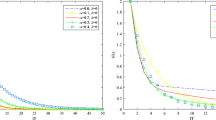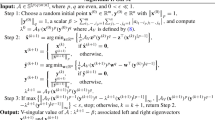Abstract
Let \(\Omega =\{ z \in {\mathbb {R}}{^n}|Gz=0,G\in {\mathbb {R}}^{k \times n}\}\) and \(\mathbb{S}\mathbb{R}_\Omega ^{n \times n}=\{A\in {\mathbb {R}}^{n\times n}|(Ax,y)=(x,Ay),\forall x,y \in \Omega \}\). In this paper, we first consider the following problem (Problem 1): Given \(A\in {\mathbb {R}}^{m\times n}\), \(B\in \mathbb {R}^{n \times q }\) and \(D\in \mathbb {R}^{m \times q }\), find \(X\in \mathbb{S}\mathbb{R}_\Omega ^{n \times n}\) such that \(AXB=D\). Further, we consider an associated optimal approximation problem: Given \({\tilde{X}} \in {\mathbb {R}}^{n\times n}\), find \({\hat{X}}\in S_E\) such that \( \Vert \hat{X} - \tilde{X}\Vert ={\min \limits _{X\in S_E}}\Vert X - {\tilde{X}}\Vert \), where \(S_E\) is the solution set of Problem 1. The solvability conditions and the representation of the general solution of Problem 1 are derived by using the generalized inverses, and then, the unique approximation solution \({\hat{X}}\) of the optimal approximation problem are deduced by applying the Kronecker product of matrices. Finally, two numerical examples are presented to show the correctness of our results.
Similar content being viewed by others
References
Avdonin SA, Belishev MI, Ivanov SA (1992) Boundary control and a matrix inverse problem for the equation. Math USSR-Sbornik 72(2):287–310
Braden HW (1998) The equations \(A^\top X\pm X^\top A=B\). SIAM J Appl Math 20(2):295–302
Chen J-L, Chen X-H (2002) Special matrices. Tsinghua University Press, Beijing (In Chinese)
Cheney EW (1982) Introduction to approximation theory. AMS Chelsea Publishing, Providence
Cvetković-Ilić DS (2008a) Re-nnd solutions of the matrix equation \(AXB=C\). J Aust Math Soc 84:63–72
Cvetković-Ilić DS (2008b) The solutions of some operator equations. J Korean Math Soc 45(5):1417–1425
Deng Y-B, Bai Z-Z, Gao Y-H (2006) Iterative orthogonal direction methods for Hermitian minimum norm solutions of two consistent matrix equations. Numer Linear Algebra Appl 13(10):801–823
Dong B, Lin MM, Chu MT (2009) Parameter reconstruction of vibration systems from partial eigeninformation. J Sound Vib 327:391–401
Khatri CG, Mitra SK (1976) Hermitian and nonnegative definite solutions of linear matrix equations. SIAM J Appl Math 31(4):579–585
Lancaster P, Tismenetsky M (1985) The theory of matrices, 2nd edn. Academic Press, New York
Lei Y, Liao A-P, Zhang L (2007) Minimization problem for symmetric orthogonal anti-symmetric matrices. J Comput Math 25(2):211–220
Liao A-P, Bai Z-Z (2002) The constrained solutions of two matrix equations. Acta Math Sin Engl Ser 18(4):671–678
Liao A-P, Bai Z-Z (2003) Least-squares solution of \(AXB=D\) over symmetric positive semidefinite matrices \(X\). J Comput Math 21(2):175–182
Liao A-P, Bai Z-Z, Lei Y (2005) Best approximate solution of matrix equation \(AXB+CYD=E\). SIAM J Matrix Anal Appl 27(3):675–688
Liu X, Wang Q-W (2017) The least squares Hermitian (anti)reflexive solution with the least norm to matrix equation \(AXB=C\). Math Probl Eng 2017:1–6
Peng Z-Y (2005) An iteration method for the least squares symmetric solution of the linear matrix equation \(AXB=C\). Appl Math Comput 170:711–723
Peng Y-X, Hu X-Y, Zhang L (2005) An iteration method for the symmetric solutions and the optimal approximation solution of the matrix equation \(AXB=C\). Appl Math Comput 160:763–777
Rogers GS (1980) Matrix derivatives. Lecture notes in statistics, vol 2. Marcel Dekker, Inc, New York
Tian Y-G (2000) The solvability of two linear matrix equations. Linear Multilinear Algebra 48(2):123–147
Udwadia FE (2005) Structural identification and damage detection from noisy modal data. J Aerosp Eng 18:179–187
Wonham WM (1979) Linear multivariable control: a geometric approach. Springer, New York
Young PD, Young DM, Young MM (2017) A general Hermitian nonnegative-definite solution to the matrix equation \(AXB=C\). Adv Linear Algebra Matrix Theory 7:7–17
Yuan Y-X (1998) On the symmetric solutions of a class of linear matrix equation. J Eng Math 15(3):25–29 (In Chinese)
Yuan Y-X (2009) A symmetric inverse eigenvalue problem in structural dynamic model updating. Appl Math Comput 213:516–521
Yuan Y-X, Dai H (2005) A class of inverse problem for matrices on subspace. Numer Math A J Chin Univ 27(1):69–76 (In Chinese)
Yuan Y-X, Dai H (2008) Generalized reflexive solutions of the matrix equation \(AXB=D\) and an associated optimal approximation problem. Comput Math Appl 56:1643–1649
Yuan Y-X, Dai H (2012) An inverse problem for undamped gyroscopic systems. J Comput Appl Math 236:2574–2581
Zhang X (2004) Hermitian nonnegative-definite and positive-definite solutions of the matrix equation \(AXB=C\). Appl Math E-Notes 4:40–47
Acknowledgements
The authors would like to express their gratitude to the editor and the anonymous reviewers for their helpful comments and suggestions, which have improved the presentation of the paper.
Author information
Authors and Affiliations
Corresponding author
Additional information
Communicated by Jinyun Yuan.
Publisher's Note
Springer Nature remains neutral with regard to jurisdictional claims in published maps and institutional affiliations.
Rights and permissions
Springer Nature or its licensor (e.g. a society or other partner) holds exclusive rights to this article under a publishing agreement with the author(s) or other rightsholder(s); author self-archiving of the accepted manuscript version of this article is solely governed by the terms of such publishing agreement and applicable law.
About this article
Cite this article
Hu, S., Yuan, Y. The symmetric solution of the matrix equation \(AXB=D\) on subspace. Comp. Appl. Math. 41, 373 (2022). https://doi.org/10.1007/s40314-022-02093-w
Received:
Revised:
Accepted:
Published:
DOI: https://doi.org/10.1007/s40314-022-02093-w




